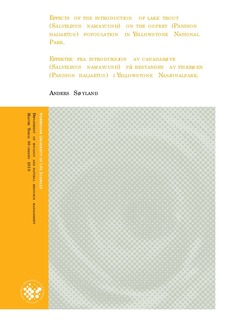| dc.description.abstract | In recent years the number and reproduction of ospreys (Pandion haliaetus) nesting on Yellowstone Lake in Yellowstone National Park (YNP), USA, has been declining. The main hypothesis is that the decline in nesting ospreys is due to the introduction of the lake trout (Salvelinus namaycush), which is believed to have reduced the cutthroat trout (Oncorhynchus clarki bouvieri) population in Yellowstone Lake substantially. The lake trout inhabit deeper water range than the cutthroat and is therefore not within reach of the ospreys. During the summer of 2010 I monitored ospreys on Yellowstone Lake to study their foraging habits and reproductive outcome. I found that the foraging behavior has changed substantially for the ospreys since the introduction of lake trout. Despite more than 60 hours of monitoring, I did not observe any ospreys foraging or attempting to forage at Yellowstone Lake. This is in contrast to the situation before the decline in the cutthroat trout population, when ospreys regularly were seen foraging at the lake. I also studied the change in numbers of nesting ospreys and their reproductive parameters in YNP, based on monitoring statistics from 1987 to 2010. The data showed a statistically significant change in distribution of both active and successful nests, on and away from Yellowstone Lake, in the period 1987-2001 vs. 2006-2010. Yellowstone Lake used to have a majority of the active nests in the park in 1987-2001, but in 2006 and 2010 there have been just a few active nests on the lake. The reproductive success from the nests on the lake also has been low in the last years. By studying catch statistics for the cutthroat trout in Yellowstone Lake, I found a significant positive correlation between the cutthroat trout population and both number of nesting ospreys and reproductive outcome. The outcome from my study supports the hypothesis that the ospreys nesting on Yellowstone Lake have been affected in a negative way by the change in the fish community. The declining cutthroat population probably has affected the foraging success of the ospreys and in turn led to reproduction failure due to lack of available fish to prey upon. Sammendrag
De siste årene har det vært en nedgang i antall og reproduksjonen hos fiskeørn (Pandion haliaetus)
som hekker ved Yellowstone Lake i Yellowstone Nasjonalpark, USA. Hovedhypotesen er at
nedgangen i hekkebestanden skyldes introduksjon av canadarøye (Salvelinus namaycush), som man
tror har forårsaket en kraftig bestandsnedgang av cutthroat trout (Oncorhynchus clarki bouvieri ) i
Yellowstone Lake. Canadarøya står dypere i vannmassene enn cutthroat trout, og er derfor utenfor
fangstrekkevidde for fiskeørnen. I løpet av sommeren 2010 observerte jeg fiskeørnbestanden ved
Yellowstone Lake, med hensikt å studere næringssøk og reproduksjon. Jeg fant ut at fangstadferden
til fiskeørnene har forandret seg markant. På tross av mer enn 60 timer med observering, så jeg ikke
en eneste fiskeørn som fanget fisk eller forsøkte å fange fisk på Yellowstone Lake. Dette står i sterk
kontrast til situasjonen før nedgangen i bestanden av cutthroat trout, da det reglemessig ble
observert fiskeørner som fanget fisk i innsjøen. Jeg studerte også forandringen i bestandsantall og
reproduksjon hos hekkende par fiskeørn i Yellowstone Nasjonalpark, basert på overvåkningsdata fra
1987 til 2010. Dataene viste en statistisk signifikant forandring i fordelingen av både aktive og
suksessfulle reir, på og utenfor Yellowstone Lake, i perioden 1987-2001 kontra perioden 2006-2010. I
perioden 1987-2001 var majoriteten av aktive fiskeørnreir i Yellowstone lokalisert ved Yellowstone
Lake, mens i 2006 og 2010 har det bare vært et par reir ved innsjøen. Reproduksjonen fra reirene ved
Yellowstone Lake har også vært lav de siste årene. Ved å studere fangststatistikk for cutthroat trout I
Yellowstone Lake, fant jeg en signifikant positiv korrelasjon mellom bestanden av cutthroat trout og
både antall hekkende fiskeørn og reproduksjonssuksess. Resultatet fra mitt studie bygger opp under
hypotesen om at hekkebestanden av fiskeørn ved Yellowstone Lake har blitt negativt påvirket av
forandringen i fiskesamfunnet. En nedgang i bestanden av cutthroat trout har trolig påvirket
fangstsuksessen til fiskeørnene og dermed ført til reproduksjonssvikt på grunn av dårlig
næringstilgang. | en_US |
